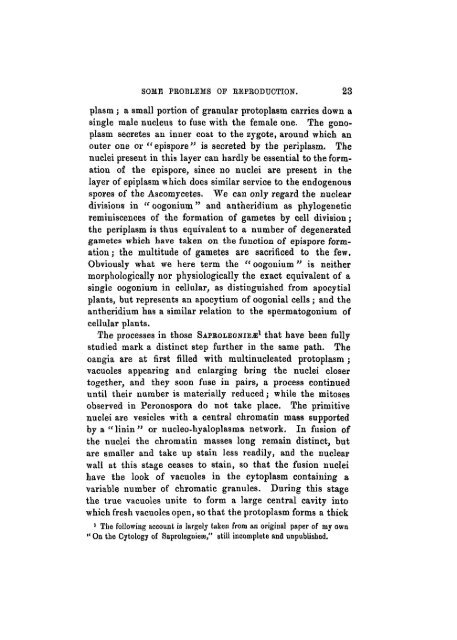Some Problems of Reproduction: a Comparative Study of ...
Some Problems of Reproduction: a Comparative Study of ...
Some Problems of Reproduction: a Comparative Study of ...
Create successful ePaper yourself
Turn your PDF publications into a flip-book with our unique Google optimized e-Paper software.
SOME PROBLEMS OF REPRODUCTION. 23<br />
plasm; a small portion <strong>of</strong> granular protoplasm carries down a<br />
single male nucleus to fuse with the female one. The gonoplasm<br />
secretes an inner coat to the zygote, around which an<br />
outer one or "epispore" is secreted by the periplasm. The<br />
nuclei present in this layer can hardly be essential to the formation<br />
<strong>of</strong> the epispore, since no nuclei are present in the<br />
layer <strong>of</strong> epiplasm which does similar service to the endogenous<br />
spores <strong>of</strong> the Ascomycetes. We can only regard the nuclear<br />
divisions in " oogonium" and antheridium as phylogenetic<br />
reminiscences <strong>of</strong> the formation <strong>of</strong> gametes by cell division;<br />
the periplasm is thus equivalent to a number <strong>of</strong> degenerated<br />
gametes which have taken on the function <strong>of</strong> epispore formation;<br />
the multitude <strong>of</strong> gametes are sacrificed to the few.<br />
Obviously what we here term the " oogonium" is neither<br />
morphologically nor physiologically the exact equivalent <strong>of</strong> a<br />
single oogonium in cellular, as distinguished from apocytial<br />
plants, but represents an apocytium <strong>of</strong> oogonial cells; and the<br />
antheridium has a similar relation to the spermatogonium <strong>of</strong><br />
cellular plants.<br />
The processes in those SAPROLEGNIEJE 1 that have been fully<br />
studied mark a distinct step further in the same path. The<br />
oangia are at first filled with multinucleated protoplasm ;<br />
vacuoles appearing and enlarging bring the nuclei closer<br />
together, and they soon fuse in pairs, a process continued<br />
until their number is materially reduced j while the mitoses<br />
observed in Peronospora do not take place. The primitive<br />
nuclei are vesicles with a central chromatin mass supported<br />
by a "linin" or nucleo-hyaloplasma network. In fnsion <strong>of</strong><br />
the nuclei the chromatin masses long remain distinct, but<br />
are smaller and take up stain less readily, and the nuclear<br />
wall at this stage ceases to stain, so that the fusion nuclei<br />
have the look <strong>of</strong> vacuoles in the cytoplasm containing a<br />
variable number <strong>of</strong> chromatic granules. During this stage<br />
the true vacuoles unite to form a large central cavity into<br />
which fresh vacuoles open, so that the protoplasm forms a thick<br />
1<br />
The following account is largely taken from an original paper <strong>of</strong> my own<br />
" On the Cytology <strong>of</strong> Saprolegnieee," still incomplete and unpublished.

















